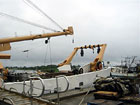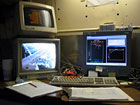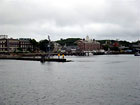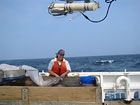

 | |||||||
|
|
Journals 2004/2005Aimee Gauthier
August 16, 2004 - Day 1 I left Boston at 7:00 am so that I would make it to Woods hole, Massachusetts on time today. Although I am nervous, I am VERY excited to finally start the project that I have been thinking about all summer long. One of my major concerns is the sea sickness, but as the great grand daughter of the harbor master in Bristol, England, I am encouraged to stay positive, take a Dramamine and I will be just fine. At 9:00 am, I safely arrived to Woods Hole. With my rain coat still on I went into the port authority office to register my car with NOAA. I was excited to meet the chief scientist, John Sibunka but I was unable to locate him. So I decided to ask permission to board the Albatross IV. (Click on thumbnail below for full version pop-up) When I entered the boat and I met John Hawkins, who is a volunteer. He periodically volunteers on NOAA vessel and takes part in the science investigations. I spoke with John for a while and he told me where to finally meet John Sibunka. John Sibunka is from Northeast Fishery Science Center in Sandy Hook, NJ. He has been doing these types of cruises for many years. John seems pleased to have a teacher-at-sea. He showed me my stateroom, I brought my belongings on to the ship and got settled in. (Click on thumbnail below for full version pop-up) In my room there are 3 beds, 2 closets and a sink. I did not need to share my stateroom which I later found out is not the norm on a cruise like this. I guess I lucked out! I do share the head, which is cold and small, yet still nicer than I expected. Once I unpacked I felt better. (Click on thumbnail below for full version pop-up) At this point, I met up with Jerry Prezioso, the chief scientist on the other leg of the cruise. He is from Northeast Fishery Science Center in Narragansett, Rhode Island. While Jerry and John S were ironing out the logistics for the cruise, they had John H and I tackle our first job of the cruise. We had to label jars that the samples will be put into after each sampling. We needed to make 125 labels (both pink and green). (Click on thumbnail below for full version pop-up) The labels are put in the inside and on outside of the bottles to ensure all of the materials are labeled appropriately. Once collected the specimen jars are sent to Poland to be analyzed. During this time in Poland, scientists analyze the zooplankton and ichthyoplankton composition, abundance, and distribution as well as the water temperature, salinities and chlorophyll - a concentration. Then the data is sent back to Jerry and John S and they assess the changing biological and physical properties that influence the productivity of the living marine ecosystems. Wow - I can't wait to get started! After labeling John H and I ate lunch. I met the cook Marc and he served a variety of meals. There was a little bit of everything, for every one. We ate the pulled pork and a salad. After John S and Jerry had their meeting the joined us for lunch and John S informed me that I could have the nautical chart. This chart had our course (and stations) all mapped out. John does this all by hand and he said I could keep the chart for my classroom. Yeah! We can not leave today until boom was fixed. Jerry informed me last week that the boom, which is the crane like structure that hangs off the boat, was not functioning correctly but it would be fixed by Monday at 2:00 or 1400. (Click on thumbnail below for full version pop-up) About the Albatross IV: It was built in 1963. It is 184 ft long and it only travels approximately 10 miles per hour. Our cruise has 4 scientist (including myself) and 23 crew members. It has the capability to hold many more individuals. (Click on thumbnail below for full version pop-up) I was (Quickly) trained on the computer program that I will be working on. All the data sampling will be stored in the computer system. Both John S and I will be working on this aspect of the research. During this training I meet Karen Tougus. I will be sharing my bathroom with her. She is also not a rookie at this boat thing like I am. Meeting all of these people has turned out to be beneficial to me because I am getting little tidbits of info about boats from everyone. (Click on thumbnail below for full version pop-up) After the training around 2:00 we pulled away from the dock. With the Dramamine in my stomach, I was fine. I took several pictures as we left Woods hole. (Click on thumbnails below for full version pop-up) The boat was no farther away from land than we needed to get trained on the inner workings of the vessel. We watched a video that explained a thing called the Oceano EEBD, which in a nutshell will give a person 10 minutes of oxygen, when needed. We also got the "sex, drugs and rock 'n roll" speech by Erich, the Albatross' Operations Officer. We then had real drills were we had to put on "gumby suits" or survival suits. These suits are supposed to save us in case of an emergency. All I know is that I would not be able to put that on when I am nervous or scared. What a nightmare!! After in the suit, we needed to meet in a designated spot and check in with our leader. Our life boat number determines where we meet which is at the fantail (or the back of the boat). I am in a life boat with Kenny (winch operator), Charlie (crew) and John Hawkins (volunteer). We are now waiting around for dinner, although I am a bit fatigued I need to rally because I am on the 6 -12 watch and it is only 4:50. I was informed by the crew that I need to get into a schedule and I would be fine. Dinner time came and went and I took a little nap, because our next station was not until 11:15. It is now 10:40 and I am preparing to actually do some science at the next station. A station is an arbitrary point of latitude and longitude where we will be sampling water. These points have been labeled on the nautical chart weeks before the cruise begins. Unfortunately, the next station did not work out according to plan. According to John, we did everything correctly but it did not work. He believes there is something the matter with the Sea Bird /CTD or the computer program. (Click on thumbnail below for full version pop-up) A CTD is the machine that is attached to the boon above my head in the picture/ It monitors conductivity, temperature and depth. It is a long very fragile tube, and the crew takes great care of it. The CTD is connected to the computer room and it records the data as the bongo nets are let in and out of the water. John decided that the CTD, which has just come back from the factory, is faulty so he wanted to try a vertical drop. A vertical drop measures a column of water. John suggested that I go to bed, so that one of us would be bright eyed and bushy tailed for the next watch. At this point it was already 1:30-ish and I had to be up in four hours. Return to Journals Index |
||||||









